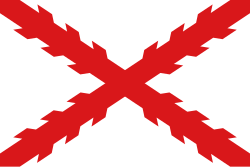Viceroyalty of New Spain
The Viceroyalty of New Spain was the name of the territories of the Spanish Empire in North America and its peripheries in Asia that were ruled by the viceroy from 1521 to 1821. New Spain was the name that the Spanish gave to what is now central and southern Mexico, and since the area's viceroy had his capital in Mexico City, the name was also used for the viceroyalty.
Viceroyalty of New Spain Virreynato de Nueva España | |
|---|---|
| 1521–1821 | |
| Anthem: | |
 map of New Spain in red, with territories claimed but not controlled in orange. | |
| Capital | Mexico City |
| Common languages | Spanish |
| Religion | Roman Catholicism |
| Government | Monarchy |
| King of Spain | |
• 1535-1556 | Charles I |
• 1813-1821 | Ferdinand VII |
| Viceroy | |
• 1535-1550 | Antonio de Mendoza |
• 1821-1821 | Juan O'Donojú |
| History | |
• | August 16 1521 |
• First viceking appointed | 1521 |
| 1810 | |
• | September 28 1821 |
| Population | |
• 1519 | 20.000.000 |
• 1810 | 7.657.300 |
| Currency | Peso de Oro |
The viceroyalty's territory included what are now the Bay Islands of Honduras (until 1643), Cayman Islands (until 1670), Central America (as far as the southern border of Costa Rica until 1821), Cuba, Florida, Hispaniola (including Haiti until 1700), Jamaica (until 1670) Mariana Islands, Mexico, Philippines, Puerto Rico, nearly all of the Southwestern United States (including all or parts of the U.S. states of California, Nevada, Utah, Colorado, Wyoming, Arizona, New Mexico, Texas, and Florida). Spain claimed areas as far north as British Columbia and Alaska, but the northern boundary of New Spain was redefined by the Adams-Onís Treaty of 1819. New Spain also included Venezuela before it was annexed to the Viceroyalty of New Granada in 1717.
The territories were separated into provinces, each of which was led by a governor, who was responsible for its administration and often also led its army and militias. The provinces were grouped together under five high courts, called audiencias in Spanish, at Santo Domingo, Mexico City, Guatemala, Guadalajara, and Manila. The high courts and the governors had much autonomy from the viceroy and carried out most duties on their own. Only on important issues would the viceroy become directly involved in ruling the provinces.
In 1821, Spain lost its continental territories and recognized the independence of Mexico, as well as that of Santo Domingo (now the Dominican Republic) when it was invaded by Haiti that year. However, Cuba, Puerto Rico, and Spanish East Indies (including the Mariana Islands and the Philippines) remained part of the Spanish Empire until it lost the 1898 Spanish–American War to the United States.
Viceroyalty Of New Spain Media
Marcha Real (1915)
Giacomo Gastaldi's 1548 map of New Spain, Nueva Hispania Tabula Nova
Official document of the New Spain government in Nahuatl announcing the transfer of powers from the outgoing viceroy Félix Berenguer de Marquina to José de Iturrigaray, who would serve until his arrest for his support of popular sovereignty in 1808
Silver coin minted in New Spain. Silver was its most important export, starting in the 16th century. 8 reales Carlos III - 1778
Indigenous man collecting cochineal with a deer tail by José Antonio de Alzate y Ramírez (1777). Cochineal was New Spain's most important export product after silver and its production was almost exclusively in the hands of indigenous cultivators
Related pages
Other websites
- MEXICO'S COLONIAL ERA--PART I: The Settlement of New Spain Archived 2009-03-01 at the Wayback Machine at mexconnect.com
- Index to the DeWitt Colony Region under New Spain Archived 2010-10-03 at the Wayback Machine at Texas A&M University
- 1492 -- Middle America at ibiblio.org the public's library and digital archive






